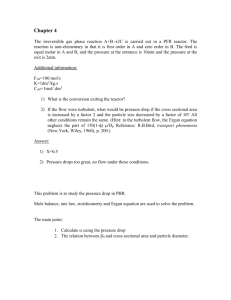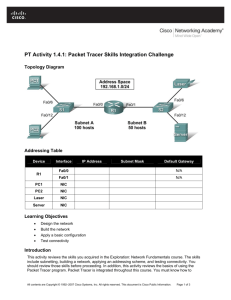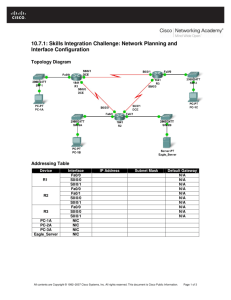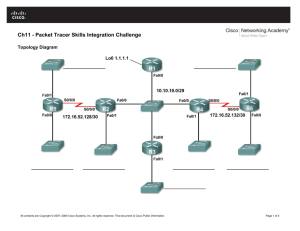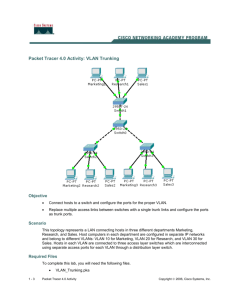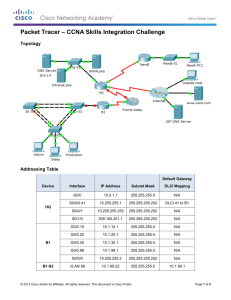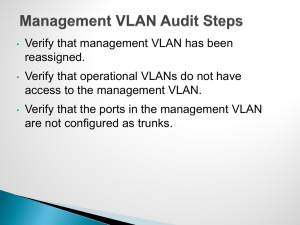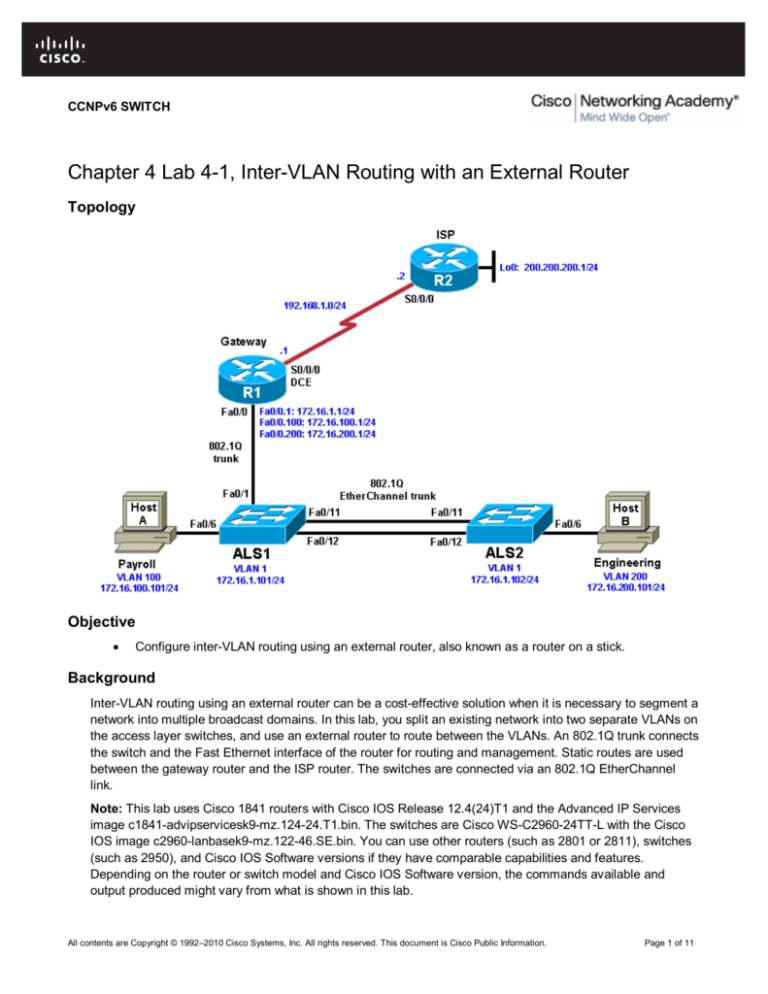
CCNPv6 SWITCH
Chapter 4 Lab 4-1, Inter-VLAN Routing with an External Router
Topology
Objective
•
Configure inter-VLAN routing using an external router, also known as a router on a stick.
Background
Inter-VLAN routing using an external router can be a cost-effective solution when it is necessary to segment a
network into multiple broadcast domains. In this lab, you split an existing network into two separate VLANs on
the access layer switches, and use an external router to route between the VLANs. An 802.1Q trunk connects
the switch and the Fast Ethernet interface of the router for routing and management. Static routes are used
between the gateway router and the ISP router. The switches are connected via an 802.1Q EtherChannel
link.
Note: This lab uses Cisco 1841 routers with Cisco IOS Release 12.4(24)T1 and the Advanced IP Services
image c1841-advipservicesk9-mz.124-24.T1.bin. The switches are Cisco WS-C2960-24TT-L with the Cisco
IOS image c2960-lanbasek9-mz.122-46.SE.bin. You can use other routers (such as 2801 or 2811), switches
(such as 2950), and Cisco IOS Software versions if they have comparable capabilities and features.
Depending on the router or switch model and Cisco IOS Software version, the commands available and
output produced might vary from what is shown in this lab.
All contents are Copyright © 1992–2010 Cisco Systems, Inc. All rights reserved. This document is Cisco Public Information.
Page 1 of 11
CCNPv6 SWITCH
Required Resources
•
2 routers (Cisco 1841 with Cisco IOS Release 12.4(24)T1 Advanced IP Services or comparable)
•
2 switches (Cisco 2960 with the Cisco IOS Release 12.2(46)SE C2960-LANBASEK9-M image or
comparable)
•
Serial and Ethernet cables
Step 1: Prepare the switches and routers for the lab.
a. Cable the network as shown in the topology diagram. On each switch, erase the startup configuration,
delete the vlan.dat file, and reload the switches. Refer to Lab 1-1, “Clearing a Switch” and Lab 1-2,
“Clearing a Switch Connected to a Larger Network” to prepare the switches for this lab.
b. Erase the startup configuration and reload the routers.
Step 2: Configure the hosts.
Configure PC hosts A and B with the IP address, subnet mask (/24), and default gateway shown in the
topology.
Step 3: Configure the routers.
a. Configure the ISP router for communication with your gateway router. The static route used for the
internal networks provides a path for the local network from the ISP. In addition, configure a loopback
interface on the ISP router to simulate an external network.
Router(config)# hostname ISP
ISP(config)# interface Loopback0
ISP(config-if)# ip address 200.200.200.1 255.255.255.0
ISP(config-if)# interface Serial0/0/0
ISP(config-if)# ip address 192.168.1.2 255.255.255.0
ISP(config-if)# no shutdown
ISP(config-if)# exit
ISP(config)# ip route 172.16.0.0 255.255.0.0 192.168.1.1
b. Configure the Gateway router to communicate with the ISP router. Notice the use of a static default route.
The default route tells the router to send any traffic with an unknown destination network to the ISP
router.
Router(config)# hostname Gateway
Gateway(config)# interface Serial0/0/0
Gateway(config-if)# ip address 192.168.1.1 255.255.255.0
Gateway(config-if)# clockrate 64000
Gateway(config-if)# no shutdown
Gateway(config-if)# exit
Gateway(config)# ip route 0.0.0.0 0.0.0.0 192.168.1.2
c.
Verify connectivity from the Gateway router using the ping command.
Was this ping successful?
All contents are Copyright © 1992–2010 Cisco Systems, Inc. All rights reserved. This document is Cisco Public Information.
Page 2 of 11
CCNPv6 SWITCH
Step 4: Configure the switches.
a. Configure the switch hostnames and IP addresses on the management VLAN according to the diagram.
By default, VLAN 1 is used as the management VLAN. Create a default gateway on both access layer
switches using the ip default-gateway ip_address command.
The following is a sample configuration for switch ALS1.
Switch(config)# hostname ALS1
ALS1(config)# interface vlan 1
ALS1(config-if)# ip address 172.16.1.101 255.255.255.0
ALS1(config-if)# no shutdown
ALS1(config-if)# exit
ALS1(config)# ip default-gateway 172.16.1.1
The following is a sample configuration for switch ALS2.
Switch(config)# hostname ALS2
ALS2(config)# interface vlan 1
ALS2(config-if)# ip address 172.16.1.102 255.255.255.0
ALS2(config-if)# no shutdown
ALS2(config-if)# exit
ALS2(config)# ip default-gateway 172.16.1.1
b.
(Optional) Set an enable secret password and configure the vty lines for Telnet access to the switch.
ALS1(config)# enable secret cisco
ALS1(config)# line vty 0 15
ALS1(config-line)# password cisco
ALS1(config-line)# login
ALS1(config-line)# end
ALS2(config)# enable secret cisco
ALS2(config)# line vty 0 15
ALS2(config-line)# password cisco
ALS2(config-line)# login
ALS2(config-line)# end
c.
By default, how many lines are available for Telnet on the access switches?
Step 5: Confirm the VLANs.
a. Verify that the only existing VLANs are the built-in VLANs. Issue the show vlan command from privileged
mode on both access layer switches.
ALS1# show vlan
VLAN Name
Status
Ports
---- -------------------------------- --------- ----------------------------1
default
active
Fa0/1, Fa0/2, Fa0/3, Fa0/4
Fa0/5, Fa0/6, Fa0/7, Fa0/8
Fa0/9, Fa0/10, Fa0/11, Fa0/12
Fa0/13, Fa0/14, Fa0/15,
Fa0/16
Fa0/17, Fa0/18, Fa0/19,
Fa0/20
All contents are Copyright © 1992–2010 Cisco Systems, Inc. All rights reserved. This document is Cisco Public Information.
Page 3 of 11
CCNPv6 SWITCH
Fa0/21, Fa0/22, Fa0/23,
Fa0/24
Gi0/1, Gi0/2
1002
1003
1004
1005
fddi-default
token-ring-default
fddinet-default
trnet-default
VLAN Type
Trans2
---- ----1
enet
1002 fddi
1003 tr
1004 fdnet
1005 trnet
act/unsup
act/unsup
act/unsup
act/unsup
SAID
MTU
Parent RingNo BridgeNo Stp
BrdgMode Trans1
---------100001
101002
101003
101004
101005
----1500
1500
1500
1500
1500
------
--------
------
--------
---ieee
ibm
-----0
0
0
0
0
----0
0
0
0
0
Remote SPAN VLANs
-----------------------------------------------------------------------------
Primary Secondary Type
Ports
------- --------- ----------------- ----------------------------------------Which VLAN is the default management VLAN for Ethernet? What types of traffic are carried on this VLAN?
Step 6: Configure trunk links and EtherChannel on switches.
a. Use the Fast Ethernet 0/11 and 0/12 ports of ALS1 and ALS2 to create an EtherChannel trunk between
the switches.
ALS1# configure terminal
Enter configuration commands, one per line. End with CNTL/Z.
ALS1(config)# interface range fastEthernet 0/11 - 12
ALS1(config-if-range)# switchport mode trunk
ALS1(config-if-range)# channel-group 1 mode desirable
ALS1(config-if-range)# end
ALS2# configure terminal
Enter configuration commands, one per line. End with CNTL/Z.
ALS2(config)# interface range fastEthernet 0/11 - 12
ALS2(config-if-range)# switchport mode trunk
ALS2(config-if-range)# channel-group 1 mode desirable
ALS2(config-if-range)# end
b. Verify the EtherChannel configuration using the show etherchannel command.
ALS1# show etherchannel
Flags: D - down
I - stand-alone
H - Hot-standby
1 summary
P - in port-channel
s - suspended
(LACP only)
All contents are Copyright © 1992–2010 Cisco Systems, Inc. All rights reserved. This document is Cisco Public Information.
Page 4 of 11
CCNPv6 SWITCH
R
U
u
w
d
-
Layer3
S - Layer2
in use
f - failed to allocate aggregator
unsuitable for bundling
waiting to be aggregated
default port
Number of channel-groups in use: 1
Number of aggregators:
1
Group Port-channel Protocol
Ports
------+-------------+-----------+-------------------------------------------1
Po1(SU)
PAgP
Fa0/11(P)
Fa0/12(P)
Step 7: Configure VTP.
a. Set up the VTP domain for the access layer switches in global configuration mode. The default VTP mode
is server for both switches. Configure ALS2 as a VTP client, and leave ALS1 as a server. Configure the
VTP domain name and version on VTP server ALS1.
ALS2(config)# vtp mode client
Setting device to VTP CLIENT mode.
ALS1(config)# vtp domain SWLAB
Changing VTP domain name from NULL to SWLAB
%SW_VLAN-6-VTP_DOMAIN_NAME_CHG: VTP domain name changed to SWLAB.
ALS1(config)# vtp version 2
b. Use the show vtp status command to verify the ALS1 VTP configuration and that client ALS2 has
learned the new VTP domain information from ALS1.
ALS1# show vtp status
VTP Version
: running VTP2
Configuration Revision
: 1
Maximum VLANs supported locally : 255
Number of existing VLANs
: 5
VTP Operating Mode
: Server
VTP Domain Name
: SWLAB
VTP Pruning Mode
: Disabled
VTP V2 Mode
: Enabled
VTP Traps Generation
: Disabled
MD5 digest
: 0x6A 0x1A 0x90 0xA3 0x10 0xCE 0x86 0xFA
Configuration last modified by 172.16.1.101 at 2-28-10 00:36:24
Local updater ID is 172.16.1.101 on interface Vl1 (lowest numbered VLAN
interface found)
ALS2# show vtp status
VTP Version
: running VTP2
Configuration Revision
: 1
Maximum VLANs supported locally : 255
Number of existing VLANs
: 5
VTP Operating Mode
: Client
VTP Domain Name
: SWLAB
VTP Pruning Mode
: Disabled
VTP V2 Mode
: Enabled
VTP Traps Generation
: Disabled
MD5 digest
: 0x6A 0x1A 0x90 0xA3 0x10 0xCE 0x86 0xFA
Configuration last modified by 172.16.1.101 at 2-28-10 00:36:24
All contents are Copyright © 1992–2010 Cisco Systems, Inc. All rights reserved. This document is Cisco Public Information.
Page 5 of 11
CCNPv6 SWITCH
Step 8: Configure VLANs and switch access ports.
a. Configure the VLAN 100 named Payroll and VLAN 200 named Engineering on VTP server ALS1.
ALS1(config)# vlan
ALS1(config-vlan)#
ALS1(config-vlan)#
ALS1(config-vlan)#
100
name Payroll
vlan 200
name Engineering
b. Use the show vlan brief command on ALS2 to verify that ALS2 has learned the new VLANs from ALS1.
ALS2# show vlan brief
VLAN Name
Status
Ports
---- -------------------------------- --------- ----------------------------1
default
active
Fa0/1, Fa0/2, Fa0/3, Fa0/4
Fa0/5, Fa0/6, Fa0/7, Fa0/8
Fa0/9, Fa0/10, Fa0/13, Fa0/14
Fa0/15, Fa0/16, Fa0/17,
Fa0/18
Fa0/19, Fa0/20, Fa0/21,
Fa0/22
Fa0/23, Fa0/24, Gi0/1, Gi0/2
100 Payroll
active
200 Engineering
active
1002 fddi-default
act/unsup
1003 trcrf-default
act/unsup
1004 fddinet-default
act/unsup
1005 trbrf-default
act/unsup
c.
Configure the switch access ports for the hosts according to the diagram. Statically set the switch port
mode to access, and use Spanning Tree PortFast on the interfaces. Assign the host attached to ALS1
Fast Ethernet 0/6 to VLAN 100, and the host attached to ALS2 Fast Ethernet 0/6 to VLAN 200.
ALS1(config)# interface fastEthernet 0/6
ALS1(config-if)# switchport mode access
ALS1(config-if)# switchport access vlan 100
ALS1(config-if)# spanning-tree portfast
%Warning: portfast should only be enabled on ports connected to a single
host. Connecting hubs, concentrators, switches, bridges, etc... to this
interface when portfast is enabled, can cause temporary bridging loops.
Use with CAUTION
%Portfast has been configured on FastEthernet0/6 but will only
have effect when the interface is in a non-trunking mode.
ALS2(config)# interface fastEthernet 0/6
ALS2(config-if)# switchport mode access
ALS2(config-if)# switchport access vlan 200
ALS2(config-if)# spanning-tree portfast
%Warning: portfast should only be enabled on ports connected to a single
host. Connecting hubs, concentrators, switches, bridges, etc... to this
interface when portfast is enabled, can cause temporary bridging loops.
Use with CAUTION
%Portfast has been configured on FastEthernet0/6 but will only
have effect when the interface is in a non-trunking mode.
d. Use the show vlan brief command to verify that Fa0/6 is in VLAN 100 on ALS1 and in VLAN 200 on
ALS2.
All contents are Copyright © 1992–2010 Cisco Systems, Inc. All rights reserved. This document is Cisco Public Information.
Page 6 of 11
CCNPv6 SWITCH
ALS1# show vlan brief
VLAN Name
Status
Ports
---- -------------------------------- --------- ----------------------------1
default
active
Fa0/1, Fa0/2, Fa0/3, Fa0/4
Fa0/5, Fa0/7, Fa0/8, Fa0/9
Fa0/10, Fa0/13, Fa0/14,
Fa0/15
Fa0/16, Fa0/17, Fa0/18,
Fa0/19
Fa0/20, Fa0/21, Fa0/22,
Fa0/23
Fa0/24, Gi0/1, Gi0/2
100 Payroll
active
Fa0/6
200 Engineering
active
1002 fddi-default
act/unsup
1003 trcrf-default
act/unsup
1004 fddinet-default
act/unsup
1005 trbrf-default
act/unsup
ALS2# show vlan brief
VLAN Name
Status
Ports
---- -------------------------------- --------- ----------------------------1
default
active
Fa0/1, Fa0/2, Fa0/3, Fa0/4
Fa0/5, Fa0/7, Fa0/8, Fa0/9
Fa0/10, Fa0/13, Fa0/14,
Fa0/15
Fa0/16, Fa0/17, Fa0/18,
Fa0/19
Fa0/20, Fa0/21, Fa0/22,
Fa0/23
Fa0/24, Gi0/1, Gi0/2
100 Payroll
active
200 Engineering
active
Fa0/6
1002 fddi-default
act/unsup
1003 trcrf-default
act/unsup
1004 fddinet-default
act/unsup
1005 trbrf-default
act/unsup
Step 9: Configure ALS1 trunking to the Gateway router.
Configure switch ALS1 interface Fast Ethernet 0/1 for trunking with the Gateway router Fast Ethernet
interface, according to the topology diagram.
ALS1(config)# interface fastEthernet 0/1
ALS1(config-if)# switchport mode trunk
ALS1(config-if)# end
Note: Optionally, you can apply the spanning-tree portfast trunk command to interface Fa0/1 of switch
ALS1. This allows the link to the router to rapidly transition to the forwarding state despite being a trunk.
Step 10: Configure the Gateway router Fast Ethernet interface for VLAN trunking.
The native VLAN cannot be configured on a subinterface for Cisco IOS releases earlier than 12.1(3)T. The
native VLAN IP address must be configured on the physical interface. Other VLAN traffic is configured on
subinterfaces. Cisco IOS release 12.1(3)T and later support native VLAN configuration on a subinterface with
the encapsulation dot1q native command. If a subinterface is configured using the encapsulation dot1q
All contents are Copyright © 1992–2010 Cisco Systems, Inc. All rights reserved. This document is Cisco Public Information.
Page 7 of 11
CCNPv6 SWITCH
native command, the configuration on the physical interface is ignored. This technique is used in the lab
configuration.
a. Create a subinterface for each VLAN. Enable each subinterface with the proper trunking protocol, and
configure it for a particular VLAN with the encapsulation command. Assign an IP address to each
subinterface, which hosts on the VLAN can use as their default gateway.
The following is a sample configuration for the Fast Ethernet 0/0 interface.
Gateway(config)# interface fastEthernet 0/0
Gateway(config-if)# no shut
The following is a sample configuration for the VLAN 1 subinterface.
Gateway(config)# interface fastEthernet 0/0.1
Gateway(config-subif)# description Management VLAN 1
Gateway(config-subif)# encapsulation dot1q 1 native
Gateway(config-subif)# ip address 172.16.1.1 255.255.255.0
Note: For enhanced switch security, it is considered best practice to use independent unused VLANs for
native and management VLANs.
The following is a sample configuration for the VLAN 100 subinterface.
Gateway(config-subif)#
Gateway(config-subif)#
Gateway(config-subif)#
Gateway(config-subif)#
interface fastEthernet 0/0.100
description Payroll VLAN 100
encapsulation dot1q 100
ip address 172.16.100.1 255.255.255.0
The following is a sample configuration for the VLAN 200 subinterface.
Gateway(config-subif)#
Gateway(config-subif)#
Gateway(config-subif)#
Gateway(config-subif)#
Gateway(config-subif)#
interface fastEthernet 0/0.200
description Engineering VLAN 200
encapsulation dot1q 200
ip address 172.16.200.1 255.255.255.0
end
b. Use the show ip interface brief command to verify the interface configuration and status.
Gateway# show ip interface brief
Interface
IP-Address
Protocol
FastEthernet0/0
unassigned
FastEthernet0/1.1
172.16.1.1
FastEthernet0/1.100 172.16.100.1
FastEthernet0/1.200 172.16.200.1
FastEthernet0/1
unassigned
Serial0/0/0
192.168.1.1
Serial0/0/1
unassigned
c.
OK? Method Status
YES
YES
YES
YES
YES
YES
YES
unset
manual
manual
manual
unset
manual
unset
up
up
up
up
up
up
up
up
administratively down down
up
up
administratively down down
Use the show interfaces description command to verify the interface status and description assigned.
Gateway# show interfaces description
Interface
Status
Fa0/0
up
Fa0/0.1
up
Fa0/0.100
up
Fa0/0.200
up
Fa0/1
admin down
Se0/0/0
up
Se0/0/1
admin down
Protocol
up
up
up
up
down
up
down
Description
Management VLAN 1
Payroll VLAN 100
Engineering VLAN 200
d. Use the show vlans command on the Gateway router.
All contents are Copyright © 1992–2010 Cisco Systems, Inc. All rights reserved. This document is Cisco Public Information.
Page 8 of 11
CCNPv6 SWITCH
Gateway# show vlans
Virtual LAN ID:
1 (IEEE 802.1Q Encapsulation)
vLAN Trunk Interface:
FastEthernet0/1.1
This is configured as native Vlan for the following interface(s) :
FastEthernet0/1
Protocols Configured:
IP
Other
Address:
172.16.1.1
Received:
198
0
Transmitted:
54
29
277 packets, 91551 bytes input
83 packets, 15446 bytes output
Virtual LAN ID:
100 (IEEE 802.1Q Encapsulation)
vLAN Trunk Interface:
FastEthernet0/1.100
Protocols Configured:
IP
Address:
172.16.100.1
Received:
1
Transmitted:
25
0 packets, 0 bytes input
25 packets, 2350 bytes output
Virtual LAN ID:
200 (IEEE 802.1Q Encapsulation)
vLAN Trunk Interface:
FastEthernet0/1.200
Protocols Configured:
IP
Address:
172.16.200.1
Received:
1
Transmitted:
25
0 packets, 0 bytes input
25 packets, 2350 bytes output
e. Use the show cdp neighbor detail command on the Gateway router to verify that ALS1 is a neighbor.
Telnet to the IP address given in the CDP information.
Gateway# show cdp neighbor detail
------------------------Device ID: ISP
Entry address(es):
IP address: 192.168.1.2
Platform: Cisco 1841, Capabilities: Router Switch IGMP
Interface: Serial0/0/0, Port ID (outgoing port): Serial0/0/0
Holdtime : 174 sec
Version :
Cisco IOS Software, 1841 Software (C1841-ADVIPSERVICESK9-M), Version
12.4(24)T1,
RELEASE SOFTWARE (fc3)
Technical Support: http://www.cisco.com/techsupport
Copyright (c) 1986-2009 by Cisco Systems, Inc.
Compiled Fri 19-Jun-09 13:56 by prod_rel_team
advertisement version: 2
VTP Management Domain: ''
All contents are Copyright © 1992–2010 Cisco Systems, Inc. All rights reserved. This document is Cisco Public Information.
Page 9 of 11
CCNPv6 SWITCH
------------------------Device ID: ALS1
Entry address(es):
IP address: 172.16.1.101
Platform: cisco WS-C2960-24TT-L, Capabilities: Switch IGMP
Interface: FastEthernet0/0.1, Port ID (outgoing port): FastEthernet0/1
Holdtime : 118 sec
Version :
Cisco IOS Software, C2960 Software (C2960-LANBASEK9-M), Version 12.2(46)SE,
RELE
ASE SOFTWARE (fc2)
Copyright (c) 1986-2008 by Cisco Systems, Inc.
Compiled Thu 21-Aug-08 15:59 by nachen
advertisement version: 2
Protocol Hello: OUI=0x00000C, Protocol ID=0x0112; payload len=27,
value=0000000
0FFFFFFFF010221FF000000000000001D46350C80FF0000
VTP Management Domain: 'SWLAB'
Native VLAN: 1
Duplex: full
Was the Telnet successful?
Step 11: Verify inter-VLAN routing on the Gateway router and the host devices.
a. Ping to the 200.200.200.1 ISP loopback interface from either host. Was this ping successful?
b. Ping from Host A to Host B. Was this ping successful?
c.
Telnet to the ALS2 VLAN 1 management IP address from the Engineering host. Was this Telnet
successful?
If any of the tests failed, make the necessary corrections to the configurations for the router and switches.
All contents are Copyright © 1992–2010 Cisco Systems, Inc. All rights reserved. This document is Cisco Public Information.
Page 10 of 11
CCNPv6 SWITCH
Router Interface Summary Table
Router Model
Router Interface Summary
Ethernet Interface
Ethernet Interface
Serial Interface
#1
#2
#1
Serial Interface
#2
1700
Fast Ethernet 0
(FA0)
Fast Ethernet 1
(FA1)
Serial 0 (S0)
Serial 1 (S1)
1800
Fast Ethernet 0/0
(FA0/0)
Fast Ethernet 0/1
(FA0/1)
Serial 0/0/0
(S0/0/0)
Serial 0/0/1
(S0/0/1)
2600
Fast Ethernet 0/0
(FA0/0)
Fast Ethernet 0/1
(FA0/1)
Serial 0/0 (S0/0)
Serial 0/1 (S0/1)
2800
Fast Ethernet 0/0
(FA0/0)
Fast Ethernet 0/1
(FA0/1)
Serial 0/0/0
(S0/0/0)
Serial 0/0/1
(S0/0/1)
Note: To find out how the router is configured, look at the interfaces to identify the type of router
and how many interfaces the router has. Rather than list all combinations of configurations for each
router class, this table includes identifiers for the possible combinations of Ethernet and serial
interfaces in the device. The table does not include any other type of interface, even though a
specific router might contain one. For example, for an ISDN BRI interface, the string in parenthesis
is the legal abbreviation that can be used in Cisco IOS commands to represent the interface.
All contents are Copyright © 1992–2010 Cisco Systems, Inc. All rights reserved. This document is Cisco Public Information.
Page 11 of 11

